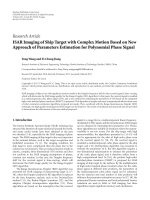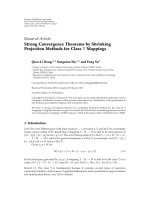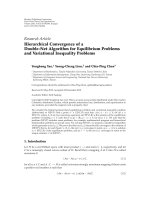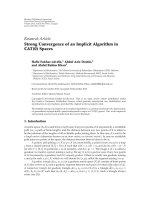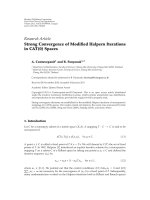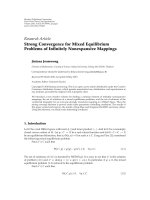Báo cáo hóa học: " Research Article Strong Convergence of an Implicit Iteration Algorithm for a Finite Family of " potx
Bạn đang xem bản rút gọn của tài liệu. Xem và tải ngay bản đầy đủ của tài liệu tại đây (494.38 KB, 10 trang )
Hindawi Publishing Corporation
Journal of Inequalities and Applications
Volume 2008, Article ID 280908, 10 pages
doi:10.1155/2008/280908
Research Article
Strong Convergence of an Implicit Iteration
Algorithm for a Finite Family of Pseudocontractive
Mappings
Yonghong Yao
1
and Yeong-Cheng Liou
2
1
Department of Mathematics, Tianjin Polytechnic University, Tianjin 300160, China
2
Department of Information Management, Cheng Shiu University, Kaohsiung 833, Taiwan
Correspondence should be addressed to Yonghong Yao,
Received 2 December 2007; Accepted 2 January 2008
Recommended by Ram Verma
Strong convergence theorems for approximation of common fixed points of a finite family of
pseudocontractive mappings are proven in Banach spaces using an implicit iteration scheme. The
results presented in this paper improve and extend the corresponding results of Osilike, Xu and Ori,
Chidume and Shahzad, and others.
Copyright q 2008 Y. Yao and Y C. Liou. This is an open access article distributed under the Creative
Commons Attribution License, which permits unrestricted use, distribution, and reproduction in
any medium, provided the original work is properly cited.
1. Introduction
Let E be a real Banach space and let J denote the normalized duality mapping from E into 2
E
∗
given by
Jx
x
∗
∈ E
∗
:
x, x
∗
x
2
x
∗
2
, 1.1
where E
∗
denotes the dual space of E and ·, · denotes the generalized duality pairing. If E
∗
is
strictly convex, then J is single valued. In the sequel, we will denote the single-value duality
mapping by j.
Let C be a nonempty closed convex subset of E. Recall that a self-mapping f : C → C is
said to be a contraction if there exists a constant δ ∈ 0, 1 such that
fx − fy
≤ δx − y, ∀ x,y ∈ C. 1.2
We use Π
C
to denote the collection of all contractions on C.Thatis,Π
C
{f : f : C →
C a contraction}.
2 Journal of Inequalities and Applications
A mapping T with domain DT and RT in E is called pseudocontractive if, for all
x, y ∈ DT, there exists jx − y ∈ Jx − y such that
Tx − Ty,jx − y
≤x − y
2
. 1.3
We use FixT to denote the fixed point set of T, that is, FixT{x ∈ C : Tx x}.
Recently, Xu and Ori 1 have introduced an implicit iteration process below for a finite
family of nonexpansive mappings. Let T
1
,T
2
, ,T
N
be N self-mappings of E and suppose
that
N
i1
FixT
i
/
∅, the set of common fixed points of T
i
,i 1, 2, ,N.An implicit iteration
process for a finite family of nonexpansive mappings is defined as follows with {t
n
} areal
sequence in 0, 1, x
0
∈ E:
x
1
t
1
x
0
1 − t
1
T
1
x
1
,
x
2
t
2
x
1
1 − t
2
T
2
x
2
,
.
.
.
x
N
t
N
x
N−1
1 − t
N
T
N
x
N
,
x
N1
t
N1
x
N
1 − t
N1
T
1
x
N1
,
.
.
.
1.4
which can be written in the following compact form:
x
n
t
n
x
n−1
1 − t
n
T
n
x
n
,n≥ 1, 1.5
where T
n
T
n mod N
.
Xu and Ori proved the weak convergence of the above iterative process 1.5 to a
common fixed point of a finite family of nonexpansive mappings {T
n
}
N
n1
in a Hilbert space.
They further remarked that it is yet unclear what assumptions on the mapping and/or the
parameters {t
n
} are sufficient to guarantee the strong convergence of the sequence {x
n
}.
Very recently, Osilike 2 first extended Xu and Ori 1 from the class of nonexpansive
mappings to the more general class of strictly pseudocontractive mappings in a Hilbert space.
He proved the following two convergence theorems.
Theorem O1. Let H be a real Hilbert space and let C be a nonempty closed convex subset of H.Let
{T
i
}
N
i1
be N strictly pseudocontractive self-mappings of C such that
N
i1
FixT
i
/
∅.Letx
0
∈ C and
let {α
n
}
∞
n1
be a sequence in 0, 1 such that lim
n→∞
α
n
0. Then the sequence {x
n
}
∞
n1
defined by
x
n
α
n
x
n−1
1 − α
n
T
n
x
n
,n≥ 1, 1.6
where T
n
T
n mod N
, converges weakly to a common fixed point of the mappings {T
i
}
N
i1
.
Theorem O2. Let E be a real Banach space and let C be a nonempty closed convex subset of E.Let
{T
i
}
N
i1
be N strictly pseudocontractive self-mappings of C such that
N
i1
FixT
i
/
∅, and let {α
n
}
∞
n1
be a real sequence satisfying the conditions 0 <α
n
< 1,
∞
n1
1 − α
n
∞ and
∞
n1
1 − α
n
2
< ∞.
Let x
0
∈ C and let {x
n
}
∞
n1
be defined by
x
n
α
n
x
n−1
1 − α
n
T
n
x
n
,n≥ 1, 1.7
where T
n
T
n mod N
.Then{x
n
} converges strongly to a common fixed point of the mappings {T
i
}
N
i1
if
and only if lim inf
n→∞
dx
n
,F0.
Y. Ya o and Y C. L iou 3
Remark 1.1. We note that Theorem O1 has only weak convergence even in a Hilbert space and
Theorem O2 has strong convergence, but imposed condition lim inf
n→∞
dx
n
,F0.
In 2005, Chidume and Shahzad 3 also proved the strong convergence of the implicit
iteration process 1.5 to a common fixed point for a finite family of nonexpansive mappings.
They gave the following theorem.
Theorem CS. Let E be a uniformly convex Banach space, let C be a nonempty closed convex subset
of E.Let{T
i
}
N
i1
be N nonexpansive self-mappings of C with
N
i1
FixT
i
/
∅. Suppose that one of
the mappings in {T
i
}
N
i1
is semicompact. Let {t
n
}⊂δ, 1 − δ for some δ ∈ 0, 1. From arbitrary
x
0
∈ C, define the sequence {x
n
} by 1.5.Then{x
n
} converges strongly to a common fixed point of the
mappings {T
i
}
N
i1
.
Remark 1.2. Chidume and Shahzad gave an affirmative response to the question raised by Xu
and Ori 1, but they imposed compactness condition on some mapping of {T
i
}
N
i1
.
In this paper, we will consider a process for a finite family of pseudocontractive
mappings which include the nonexpansive mappings as special cases. Let f : C → C be a
contraction. Let {α
n
}, {β
n
},and{γ
n
} be three real sequences in 0, 1 and an initial point x
0
∈ C.
Let the sequence {x
n
} be defined by
x
1
α
1
f
x
0
β
1
x
0
γ
1
T
1
x
1
,
x
2
α
2
f
x
1
β
2
x
1
γ
2
T
2
x
2
,
.
.
.
x
N
α
N
f
x
N−1
β
N
x
N−1
γ
N
T
N
x
N
,
x
N1
α
N1
f
x
N
β
N1
x
N
γ
N1
T
1
x
N1
,
.
.
.
1.8
which can be written in the following compact form:
x
n
α
n
f
x
n−1
β
n
x
n−1
γ
n
T
n
x
n
,n≥ 1, 1.9
where T
n
T
n mod N
.
Motivated by the works in 1–6, our purpose in this paper is to study the implicit
iteration process 1.9 in the general setting of a uniformly smooth Banach space and prove the
strong convergence of the iterative process 1.9 to a common fixed point of a finite family of
pseudocontractive mappings {T
i
}
N
i1
. The results presented in this paper generalize and extend
the corresponding results of Chidume and Shahzad 3, Osilike 2,XuandOri1, and others.
2. Preliminaries
Let E be a Banach space. Recall the norm of E is said to be Gateaux differentiable and E is said
to be smooth if
lim
t→0
x ty−x
t
2.1
4 Journal of Inequalities and Applications
exists for each x, y in its unit sphere U {x ∈ E : x 1}. It is said to be uniformly Frechet
differentiable and E is said to be uniformly smooth if the limit in 2.1 is attained uniformly
for x, y ∈ U ×U. It is well known that a Banach space E is uniformly smooth if and only if the
duality map J is single valued and norm-to-norm uniformly continuous on bounded sets of E.
Recall that if C and D are nonempty subsets of a Banach space E such that C is nonempty
closed convex and D ⊂ C,thenamapQ : C → D is called a retraction from C onto D provided
Qxx for all x ∈ D. A retraction Q : C → D is sunny provided Qx tx − Qx Q
x
for all x ∈ C and t ≥ 0 whenever x tx − Qx ∈ C. A sunny nonexpansive retraction is a
sunny retraction, which is also nonexpansive.
We need the following lemmas for proof of our main results.
Lemma 2.1 see 7. Let E be a uniformly smooth Banach space, C a closed convex subset of E,
T : C → C a nonexpansive with FixT
/
∅. For each f ∈ Π
C
and every t ∈ 0, 1,then{x
t
} defined by
x
t
tf
x
t
1 − tTx
t
2.2
converges strongly as t → 0 to a fixed point of T.
In particular, if f u ∈ C is a constant, then 2.2 is reduced to the sunny nonexpansive
retraction of Reich from C onto FixT,
Qu − u, J
Qu − p
≤ 0,p∈ FixT. 2.3
Lemma 2.2 see 8. Let E be a real uniformly smooth Banach space, then there exists a nondecreasing
continuous function b : 0, ∞ → 0, ∞ satisfying
i bct ≤ cbt for all c ≥ 1;
ii lim
t→0
bt0;
iii x y
2
≤x
2
2y, jx max{x, 1}yby, for all x, y ∈ E.
The inequality iii is called Reich’s inequality.
Lemma 2.3 see 9. Let {a
n
}
∞
n0
be a sequences of nonegative real numbers satisfying the property
a
n1
≤ 1 − γ
n
a
n
γ
n
σ
n
,n≥ 0, where {γ
n
}
∞
n0
⊂ 0, 1 and {σ
n
}
∞
n0
are such that
i
∞
n0
γ
n
∞;
ii either lim sup
n→∞
σ
n
≤ 0 or
∞
n0
|γ
n
σ
n
| < ∞.
Then {a
n
}
∞
n0
converges to 0.
3. Main results
Theorem 3.1. Let E be a uniformly smooth Banach space and let C be a nonempty closed convex subset
of E.Let{T
i
}
N
i1
be N pseudocontractive self-mappings of C such that
N
i1
FixT
i
/
∅.Let{α
n
}, {β
n
},
and {γ
n
} be three real sequences in 0, 1 satisfying the following conditions:
i α
n
β
n
γ
n
1;
ii lim
n→∞
β
n
0 and lim
n→∞
α
n
/β
n
0;
iii
∞
n0
α
n
/α
n
β
n
∞.
Y. Ya o and Y C. L iou 5
For f ∈ Π
C
and given x
0
∈ C arbitrarily, let the sequence {x
n
} be defined by 1.9.Then{x
n
}
converges strongly to a common fixed point p of the mappings {T
i
}
N
i1
,wherep Qf is the unique
solution of the following variational inequality:
f − IQf,j
z − Qf
≤ 0 ∀ z ∈
N
i1
Fix
T
i
. 3.1
Proof. First, we observe that {x
n
} is bounded. Indeed, if we take a fixed point p of T,noting
that
x
n
− p
1 − γ
n
α
n
1 − γ
n
f
x
n−1
β
n
1 − γ
n
x
n−1
γ
n
T
n
x
n
− p
1 − γ
n
α
n
1 − γ
n
f
x
n−1
− fp
α
n
fp − p
1 − γ
n
β
n
x
n−1
− p
1 − γ
n
γ
n
T
n
x
n
− p
.
3.2
It follows that
x
n
− p
2
1 − γ
n
α
n
1 − γ
n
f
x
n−1
− fp
α
n
fp − p
1 − γ
n
β
n
x
n−1
− p
1 − γ
n
,j
x
n
− p
γ
n
T
n
x
n
− p, j
x
n
− p
≤
1 − γ
n
α
n
1 − γ
n
f
x
n−1
− fp
α
n
fp − p
1 − γ
n
β
n
x
n−1
− p
1 − γ
n
x
n
− p
γ
n
x
n
− p
2
,
3.3
which implies that
x
n
− p
≤
α
n
f
x
n−1
− fp
1 − γ
n
α
n
fp − p
1 − γ
n
β
n
x
n−1
− p
1 − γ
n
≤
α
n
1 − γ
n
fp − p
δα
n
β
n
1 − γ
n
x
n−1
− p
1 − δα
n
1 − γ
n
×
fp − p
1 − δ
1 −
1 − δα
n
1 − γ
n
x
n−1
− p
≤ max
fp − p
1 − δ
,
x
n−1
− p
.
3.4
Now, an induction yields
x
n
− p
≤ max
fp − p
1 − δ
,
x
0
− p
. 3.5
Hence {x
n
} is bounded, so are {fx
n
} and {T
i
x
n
} for all i 1, 2, ,N.
6 Journal of Inequalities and Applications
Observe that
x
n
− T
n
x
n
≤ α
n
f
x
n−1
− T
n
x
n
β
n
x
n−1
− T
n
x
n
−→ 0. 3.6
Set A
n
2I − T
n
−1
for all n 1, 2, ,N,itiswellknownthat{A
n
}
N
n1
are all nonexpansive
mappings and FixA
n
FixT
n
as a consequence of 10,Theorem6.Thenwehave
x
n
− A
n
x
n
A
n
A
−1
n
x
n
− A
n
x
n
≤
x
n
− T
n
x
n
. 3.7
It also follows from 3.6 that lim
n→∞
x
n
− A
n
x
n
0.
Next, we claim that
lim sup
n→∞
fp − p, j
x
n
− p
≤ 0 p ∈
N
i1
Fix
T
i
, 3.8
where p Qflim
t→0
z
t
with z
t
being the fixed point of z → tfz1 − tA
n
z see
Lemma 2.1.
Indeed, z
t
solves the fixed point equation
z
t
tf
z
t
1 − tA
n
z
t
. 3.9
Then we have
z
t
− x
n
1 − t
A
n
z
t
− x
n
t
f
z
t
− x
n
. 3.10
Thus we obtain
z
t
− x
n
2
≤ 1 − t
2
A
n
z
t
− A
n
x
n
x
n
− A
n
x
n
2
2t
f
z
t
− z
t
,j
z
t
− x
n
2t
z
t
− x
n
2
.
3.11
Noting that
f
z
t
− z
t
,j
z
t
− x
n
f
z
t
− fp,j
z
t
− x
n
fp − z
t
,j
z
t
− x
n
≤ δ
z
t
− p
z
t
− x
n
fp − z
t
,j
z
t
− x
n
.
3.12
Thus 3.11 gives
z
t
− x
n
2
≤ 1 − t
2
z
t
− x
n
x
n
− A
n
x
n
2
2δt
z
t
− p
z
t
− x
n
2t
fp − z
t
,j
z
t
− x
n
2t
z
t
− x
n
2
≤ 1 − t
2
z
t
− x
n
2
a
n
t2δt
z
t
− p
z
t
− x
n
2t
fp − z
t
,j
z
t
− x
n
2t
z
t
− x
n
2
,
3.13
where
a
n
t
2
z
t
− x
n
x
n
− A
n
x
n
x
n
− A
n
x
n
−→ 0asn −→ ∞ . 3.14
Y. Ya o and Y C. L iou 7
It follows that
z
t
− fp,j
z
t
− x
n
≤
t
2
z
t
− x
n
2
1
2t
a
n
tδ
z
t
− p
z
t
− x
n
. 3.15
Letting n →∞in 3.15 and noting 3.14 yields
lim sup
n→∞
z
t
− fp,j
z
t
− x
n
≤
t
2
M δM
z
t
− p
, 3.16
where M>0 is a constant.
For 3.9, since z
t
strongly converges to p,then{z
t
} is bounded. Hence we obtain
immediately that the set {z
t
− x
n
} is bounded. At the same time, we note that the duality
map j is norm-to-norm uniformly continuous on bounded sets of E. By letting t → 0in3.16,
it is not hard to find that the two limits can be interchanged and 3.8 is thus proven.
Finally, we show that x
n
→ p strongly.
Indeed, using Lemma 2.2 and noting that 3.4,weobtain
x
n
− p
2
≤
α
n
1 − γ
n
f
x
n−1
− p
β
n
1 − γ
n
x
n−1
− p
2
≤
β
n
1 − γ
n
2
x
n−1
− p
2
2
α
n
β
n
1 − γ
n
2
f
x
n−1
− p, j
x
n−1
− p
max
β
n
1 − γ
n
x
n−1
− p
, 1
α
n
1 − γ
n
f
x
n−1
− p
b
α
n
1 − γ
n
f
x
n−1
− p
β
n
1 − γ
n
2
x
n−1
− p
2
2
α
n
β
n
1 − γ
n
2
fp − p, j
x
n−1
− p
2
α
n
β
n
1 − γ
n
2
f
x
n−1
− fp,j
x
n−1
− p
max
β
n
1 − γ
n
x
n−1
− p
, 1
f
x
n−1
− p
α
n
1 − γ
n
b
f
x
n−1
− p
α
n
1 − γ
n
≤
1 −
α
n
α
n
2β
n
α
n
β
n
2
x
n−1
− p
2
2α
n
β
n
α
n
β
n
2
δ
x
n−1
− p
2
2α
n
β
n
α
n
β
n
2
fp − p, j
x
n−1
− p
max
β
n
1 − γ
n
x
n−1
− p
, 1
f
x
n−1
− p
α
n
α
n
β
n
b
f
x
n−1
− p
α
n
α
n
β
n
8 Journal of Inequalities and Applications
1 −
α
n
α
n
21 − δβ
n
α
n
β
n
2
x
n−1
− p
2
α
n
α
n
21 − δβ
n
α
n
β
n
2
×
2β
n
α
n
21 − δβ
n
fp − p, j
x
n−1
− p
max
β
n
1 − γ
n
x
n−1
− p
, 1
f
x
n−1
− p
α
n
β
n
α
n
21 − δβ
n
b
f
x
n−1
− p
α
n
α
n
β
n
1 − λ
n
x
n−1
− p
2
λ
n
σ
n
,
3.17
where λ
n
α
n
α
n
21 − δβ
n
/α
n
β
n
2
and
σ
n
2β
n
α
n
21 − δβ
n
fp − p, j
x
n−1
− p
max
β
n
x
n−1
− p
1 − γ
n
, 1
×
f
x
n−1
− p
α
n
β
n
α
n
21 − δβ
n
× b
f
x
n−1
− p
α
n
α
n
β
n
.
3.18
We observe that lim
n→∞
α
n
21 − δβ
n
/α
n
β
n
21 − δ,then
∞
n0
λ
n
∞ and
max{β
n
/1 − γ
n
x
n−1
− p, 1}fx
n−1
− pα
n
β
n
/α
n
21 − δβ
n
is bounded. At
the same time, from lim
n→∞
α
n
/α
n
β
n
0, we have that bfx
n−1
− pα
n
/α
n
β
n
→ 0.
This implies that lim sup
n→∞
σ
n
≤ 0.
Now, we apply Lemma 2.3 and use 3.8 to see that x
n
− p→0. This completes the
proof.
Remark 3.2. Theorem 3.1 proves the strong convergence in the framework of real uniformly
smooth Banach spaces. Our theorem extends Theorem O1 to the more general real Banach
spaces. Our result improves Theorem O2 without condition lim inf
n→∞
dx
n
,F0andat
the same time extends the mappings from nonexpansive mappings to pseudocontractive
mappings.
Corollary 3.3. Let E be a uniformly smooth Banach space and let C be a nonempty closed convex subset
of E.Let{T
i
}
N
i1
be N pseudocontractive self-mappings of C such that
N
i1
FixT
i
/
∅.Let{α
n
}, {β
n
},
and {γ
n
} be three real sequences in 0, 1 satisfying the following conditions:
i α
n
β
n
γ
n
1;
ii lim
n→∞
β
n
0 and lim
n→∞
α
n
/β
n
0;
iii
∞
n0
α
n
/α
n
β
n
∞.
For fixed u ∈ C and given x
0
∈ C arbitrarily, let the sequence {x
n
} be defined by
x
n
α
n
u β
n
x
n−1
γ
n
T
n
x
n
,n≥ 1. 3.19
Then {x
n
} converges strongly to a common fixed point p of the mappings {T
i
}
N
i1
,wherep Qu is
the unique solution of the following inequality:
u − Qu,j
z − Qu
≤ 0 ∀ z ∈
N
i1
Fix
T
i
, 3.20
where Q is a sunny nonexpansive retraction from C onto
N
i1
FixT
i
.
Y. Ya o and Y C. L iou 9
Corollary 3.4. Let E be a uniformly smooth Banach space and let C be a nonempty closed convex subset
of E.Let{T
i
}
N
i1
be N nonexpansive self-mappings of C such that
N
i1
FixT
i
/
∅.Let{α
n
}, {β
n
},and
{γ
n
} be three real sequences in 0, 1 satisfying the following conditions:
i α
n
β
n
γ
n
1;
ii lim
n→∞
β
n
0 and lim
n→∞
α
n
/β
n
0;
iii
∞
n0
α
n
/α
n
β
n
∞.
For f ∈ Π
C
and given x
0
∈ C arbitrarily, let the sequence {x
n
} be defined by 1.9.Then{x
n
}
converges strongly to a common fixed point p of the mappings {T
i
}
N
i1
,wherep Qf is the unique
solution of the following variational inequality:
f − IQf,j
z − Qf
≤ 0 ∀ z ∈
N
i1
Fix
T
i
. 3.21
Corollary 3.5. Let E be a uniformly smooth Banach space and let C be a nonempty closed convex subset
of E.Let{T
i
}
N
i1
be N nonexpansive self-mappings of C such that
N
i1
FixT
i
/
∅.Let{α
n
}, {β
n
},and
{γ
n
} be three real sequences in 0, 1 satisfying the following conditions:
i α
n
β
n
γ
n
1;
ii lim
n→∞
β
n
0 and lim
n→∞
α
n
/β
n
0;
iii
∞
n0
α
n
/α
n
β
n
∞.
For fixed u ∈ C and given x
0
∈ C arbitrarily, let the sequence {x
n
} be defined by
x
n
α
n
u β
n
x
n−1
γ
n
T
n
x
n
,n≥ 1. 3.22
Then {x
n
} converges strongly to a common fixed point p of the mappings {T
i
}
N
i1
,wherep Qu is
the unique solution of the following inequality:
u − Qup, j
z − Qu
≤ 0 ∀ z ∈
N
i1
Fix
T
i
, 3.23
where Q is a sunny nonexpansive retraction from C onto
N
i1
FixT
i
.
Remark 3.6. Corollary 3.5 improves Theorem CS without compactness assumption of map-
pings.
Acknowledgments
The authors are extremely grateful to the referee for his/her careful reading. The first author
was partially supposed by National Natural Science Foundation of China, Grant no. 10771050.
The second author was partially supposed by the Grant no. NSC 96-2221-E-230-003.
10 Journal of Inequalities and Applications
References
1 H. K. Xu and R. G. Ori, “An implicit iteration process for nonexpansive mappings,” Numerical
Functional Analysis and Optimization, vol. 22, no. 5-6, pp. 767–773, 2001.
2 M. O. Osilike, “Implicit iteration process for common fixed points of a finite family of strictly
pseudocontractive maps,” Journal of Mathematical Analysis and Applications, vol. 294, no. 1, pp. 73–81,
2004.
3 C. E. Chidume and N. Shahzad, “Strong convergence of an implicit iteration process for a finite family
of nonexpansive mappings,” Nonlinear Analysis, vol. 62, no. 6, pp. 1149–1156, 2005.
4 Y. C. Liou, Y. Yao, and R. Chen, “Iteration scheme with perturbed mapping for common fixed points
of a finite family of nonexpansive Mappings,” Fixed Point Theory and Applications, vol. 2007, Article
ID 29091, 10 pages, 2007.
5 Y. C. Liou, Y. Yao, and K. Kimura, “Strong convergence to common fixed points of a finite family of
nonexpansive mappings,” Journal of Inequalities and Applications, vol. 2007, Article ID 37513, 10 pages,
2007.
6 L. C. Ceng, N. C. Wong, and J. C. Yao, “Implicit predictor-corrector iteration process for finitely many
asymptotically quasi-nonexpansive mappings,” Journal of Inequalities and Applications, vol. 2006,
Article ID 65983, 11 pages, 2006.
7 H. K. Xu, “Viscosity approximation methods for nonexpansive mappings,” Journal of Mathematical
Analysis and Applications, vol. 298, no. 1, pp. 279–291, 2004.
8 S. Reich, “An iterative procedure for constructing zeros of accretive sets in Banach spaces,” Nonlinear
Analysis, vol. 2, no. 1, pp. 85–92, 1978.
9 H. K. Xu, “An iterative approach to quadratic optimization,” Journal of Optimization Theory and
Applications, vol. 116, no. 3, pp. 659–678, 2003.
10 R. H. Martin Jr., “Differential equations on closed subsets of a Banach space,” Transactions of the
American Mathematical Society, vol. 179, pp. 399–414, 1973.


